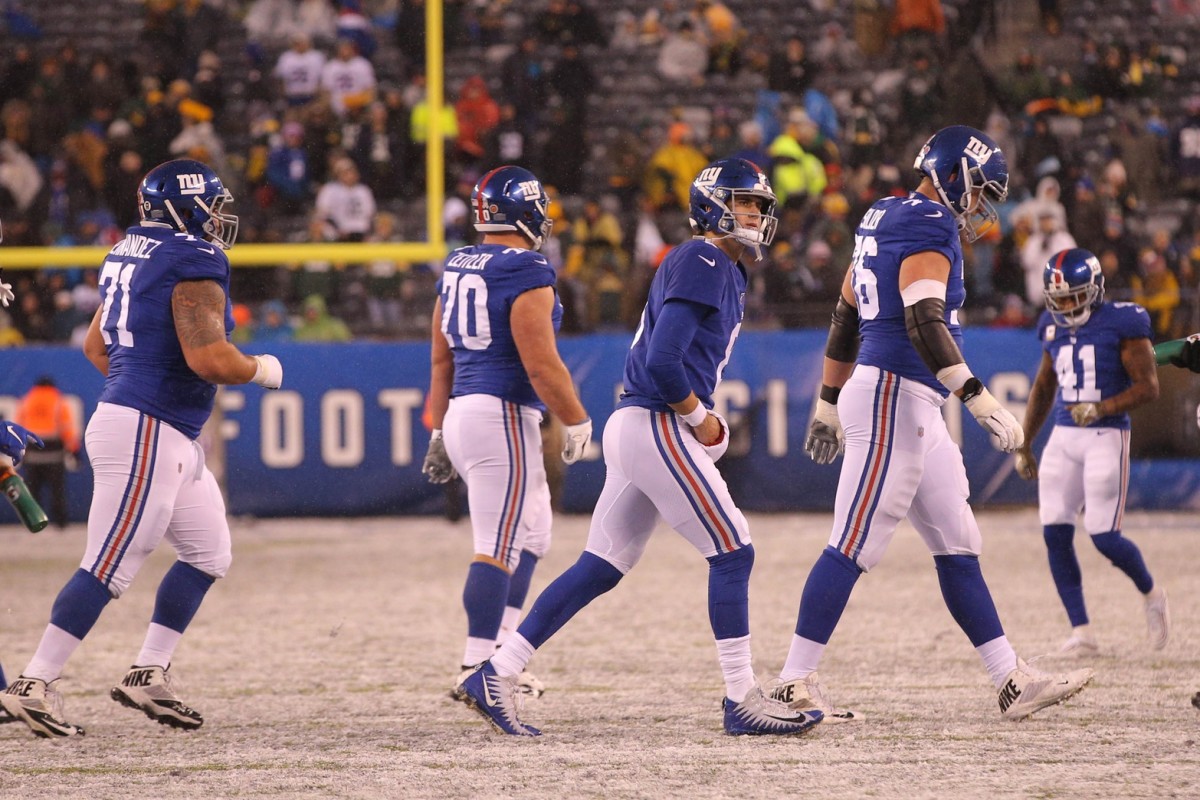5 Giants Most Critical to Daniel Jones’ Year 2 Development

Daniel Jones' rookie season was filled with mixed results that can probably be divided into team and individual.
From an individual perspective, there were the ball security issues and the misreads of some defenses, both things that are correctable and which Jones has supposedly been working on during the off-season.
And then there are the team related results--working in concert with receivers and running backs to move the chains--that were encouraging.
For example, his 61.9% was the best completion percentage for a Giants rookie quarterback drafted in the first round, beating Eli Manning’s 48.2% mark set in nine games in 2004 and Phil Simms’ 50.6% mark set in 12 games in 1979.
Jones' 24 touchdowns last year also topped the rookie year numbers set by Manning and Simms.
At the end of the day, football is a team sport, so if Jones is to take a big step forward in his second NFL season, in addition to doing what he can to improve his reads and ball security, he'll have to count on his teammates, and in particular, these five guys, to help him..
5. Offensive Tackle Andrew Thomas
Yes, even a rookie can be instrumental in a veteran’s development. Since first-round pick Andrew Thomas figures to be one of the five starting offensive linemen, he belongs int his list.
Head coach Joe Judge hasn’t said where Thomas will play, but it would be hard to imagine him not stepping in at left tackle, the position he played in college.
The lack of spring workouts is usually the time to begin grooming young players for a position switch. Unless Giants offensive line coach Marc Colombo has a trick up his sleeve to facilitate that training through virtual instruction, the likelihood of Thomas being responsible for protecting Jones’ blindside, where per PFF 11 of the 38 sacks against Jones came from, is too great to ignore.
4. Tight End Kaden Smith
After being picked up off waivers from the 49ers, Kaden Smith solidified his place on the Giants each week with a combination of serviceable blocking and, most importantly, reliable hands. Although his 41 pass targets were fifth (out of seven) among Giants receivers and tight ends with at least 30 pass targets, Smith still managed to produce the highest catch rate (75.6%).
Smith’s development could be part of the reason why the Giants didn’t feel as pressured to select a receiver in this year’s draft. Smith gives Jones another potential pass target, and insurance should Evan Engram’s luck with making it through an entire season falls short.
3. Running Back Saquon Barkley
Some might debate the importance of a running game, but the truth is that a good running back is a quarterback’s best friend. Having a running game allows an offense to be multidimensional.
If you don’t believe that to be the case, go back and look at the Giants teams where receiver Odell Beckham Jr was the only legitimate pass-catching target they had on offense and how opponents were able to tee off on Beckham (who used his talent to generate the production he did).
Getting back to Barkley, if he can get the running game going, the hope is that the Giants’ run-pass balance doesn’t have to be so slanted in favor of the pass.
Last year, Jones attempted 459 pass attempts while the Giants ran the ball 362 times. Granted, some of that was a result of the Giants usually being in catch-up mode, while Barkley’s high ankle sprain that cost him three games didn’t help (nor did the inconsistent run blocking by the offensive line).
The point is that if Barkley can take some of the onus off Jones, that should help in opening the offense up more to where Jones doesn’t have to feel as though he must do everything.
2. Receiver Golden Tate
Tate might be on the wrong side of 30, but he was the second-most productive Giants receiver (behind Darius Slayton) n the deep passing game. Tate tied Slayton for most deep-pass receptions (7), recording 230 deep passing yards, just 35 fewer than Slayton. But Tate did record one more touchdown than Slayton.
Overall, Tate was the Giants’ runaway leader in yards after catch (YAC), with 291, an average of 5.9 YAC per reception. Although Jones might not be too interested in padding his stats, having a receiver capable of picking up yards after the catch is invaluable for moving the chains.
1. Receiver Darius Slayton
Jones and Slayton greatly benefitted from coming in as rookie teammates last year in that they were able to get a head start on building their chemistry as early as the rookie minicamp.
That process continued into training camp before Slayton tweaked a hamstring, as Jones, then alternating between the second and third-string offense, got a chance to advance his rapport with Slayton.
By the time they got to the regular-season, Jones and Slayton looked like they had been playing ball together for months. Slayton, per Pro Football Focus, finished with the highest NFL Rating among the Giants receivers (103.1), catching five of his team-leading eight touchdowns from Jones.
If Jones and Slayton can pick up where they left off, the offense has the potential to thrive in what’s being projected to be a vertical passing scheme.





